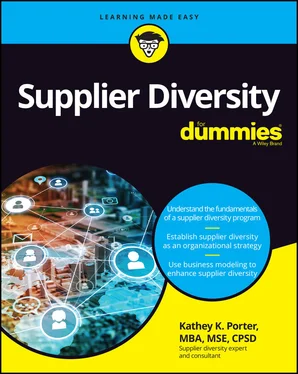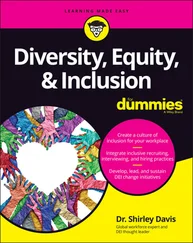Kathey K. Porter - Supplier Diversity For Dummies
Здесь есть возможность читать онлайн «Kathey K. Porter - Supplier Diversity For Dummies» — ознакомительный отрывок электронной книги совершенно бесплатно, а после прочтения отрывка купить полную версию. В некоторых случаях можно слушать аудио, скачать через торрент в формате fb2 и присутствует краткое содержание. Жанр: unrecognised, на английском языке. Описание произведения, (предисловие) а так же отзывы посетителей доступны на портале библиотеки ЛибКат.
- Название:Supplier Diversity For Dummies
- Автор:
- Жанр:
- Год:неизвестен
- ISBN:нет данных
- Рейтинг книги:4 / 5. Голосов: 1
-
Избранное:Добавить в избранное
- Отзывы:
-
Ваша оценка:
- 80
- 1
- 2
- 3
- 4
- 5
Supplier Diversity For Dummies: краткое содержание, описание и аннотация
Предлагаем к чтению аннотацию, описание, краткое содержание или предисловие (зависит от того, что написал сам автор книги «Supplier Diversity For Dummies»). Если вы не нашли необходимую информацию о книге — напишите в комментариях, мы постараемся отыскать её.
Supplier Diversity For Dummies,
Supplier Diversity For Dummies
Supplier Diversity For Dummies — читать онлайн ознакомительный отрывок
Ниже представлен текст книги, разбитый по страницам. Система сохранения места последней прочитанной страницы, позволяет с удобством читать онлайн бесплатно книгу «Supplier Diversity For Dummies», без необходимости каждый раз заново искать на чём Вы остановились. Поставьте закладку, и сможете в любой момент перейти на страницу, на которой закончили чтение.
Интервал:
Закладка:
Compliance with federal law (1969–1990)
Supplier diversity got its start with the federal government, but by 1968, several leading companies, such as General Motors and IBM (who were also federal contractors), were compelled to launch their own supplier diversity programs. Large corporations and the government have always had a close relationship. In the early days of the United States, it was nothing for the government to borrow money from private bankers when it ran a little short.
To this day, many corporations are vendors that provide the government with a variety of goods and services. With the establishment of the executive orders I cover earlier in the chapter, these vendors were under regulatory pressure to provide contracts to minority-owned businesses. Although some were inspired to create their own programs, many were motivated to simply remain compliant in order to continue to win contracts. This period came to a close because of legal challenges and backlash against laws designed to promote minority business development.
The right thing to do (1990s–early 2000s)
Up until this time, the government or the public sector was the main force creating opportunities for minority businesses. But as legal challenges abounded, businesses began to shift their focus to look at opportunities in the private sector with corporations. The leading organization that certified minority firms and advocated for minority businesses interested in doing business with corporations was (and still is) the National Minority Supplier Development Council, or NMSDC.
During this time, NMSDC strategically shifted its focus from a publicly funded organization to an organization funded by and focused on corporations. Corporations began to publicize their efforts in their communications, often touting supplier diversity as the right thing to do, and to formalize their programs by hiring personnel, developing processes, and investing in systems that allowed them to track utilization, which then can be reported.
This era was the first time a true business ecosystem was created, and minority businesses benefitted greatly. It also created a model for advocacy and certifying organizations that represent other socioeconomically disadvantaged groups such as women, the LGBTQ community, and veterans.
Making the business case (2000s–present)
The 2000s were marked by several shifts in the marketplace — the tech industry, changes in demographics, the growing influence of consumers, and the increased globalization of business — that had a tremendous impact on corporations, the likes of which they hadn’t experienced before. Each of these factors presented new challenges and raised the stakes for supplier diversity to not simply comply with government regulations or push its feel-good message as the right thing to do. Supplier diversity needed to help the organization maintain a competitive advantage by making the business case to support its reason for being.
As I describe in Chapter 7, a strong business case for supplier diversity focuses on the tangible impact or metrics you can monitor through measured performance results. It’s sustainable in ways that the phases in the two preceding sections weren’t. Compliance allows programs to be challenged or risk being shut down based on court rulings. Programs based on an emotional appeal like “the right thing to do” can shift depending on leadership’s priorities or be difficult to justify when decisions are based solely on numbers.
Pondering the Future of Supplier Diversity
Earlier in the chapter, I discuss the different phases of supplier diversity and how the industry has grown and evolved to become a strategic pillar within organizations and in communities. Just like the civil unrest of the 1960s led to the start of these programs, the civil unrest of 2020 has created a reawakening and refocus on supplier diversity as a driver of entrepreneurship and economic inclusion.
As markets continue to get more complex and competitive and external factors influence business like never before, organizations have to look at every nook and cranny to gain or maintain a competitive advantage. For instance, market factors such as the supply chain shortages of the 2021 holiday season impacted everything from food to clothing to toys to electronics. This promoted organizations to take a closer look at supplier diversity and diverse businesses as a potential solution. It’s clear we’ve moved to a hybrid phase that combines all the previous eras and also includes social equity.
As the industry continues to advance, you have to wonder what will drive the next phase of supplier diversity. Will it be a subtle shift or a major disruption? Whatever it is, you should be aware of the issues that are poised to have an impact on supplier diversity in the future.
 Today’s business challenges have created a reawakening and refocus on supplier diversity as a driver of entrepreneurship and economic inclusion.
Today’s business challenges have created a reawakening and refocus on supplier diversity as a driver of entrepreneurship and economic inclusion.
Business and program globalization
If you’re part of a global organization, I’m sure international business is an important aspect of your organization’s overall business. Whether looking to gain efficiencies or appeal to the local market, you may be tasked with extending your efforts, not just domestically but also internationally. A number of countries have aligned with leading U.S. groups to form their own programs focused on creating access to opportunities, including the following:
The Canadian Aboriginal and Minority Supplier Council
Minority Supplier Development in China
Minority Supplier Development UK (MSDUK)
Supply Nation (Australia)
The South African Supplier Diversity Council
Many international markets are at the early stages of business inclusion for diverse populations. Global supplier diversity not only helps local businesses where you may be operating but also provides another capacity-building opportunity by connecting domestic businesses to international opportunities.
Strategic advantage
Just as the demographics of the consumer markets are changing, so too is the makeup of the labor markets. Today’s employees are looking for more than just a job. They’re motivated by a higher cause and want to believe that the things they and their organizations do make society better.
Just a few short years ago, departments like sustainability; diversity, equity, and inclusion (DEI); and supplier diversity weren’t part of the traditional structure and weren’t always embraced. Now they’re an integral part of business operations and are prominently on display in communications, websites, annual reports, articles, and so on. Being able to make the business case and communicate program impact can be helpful for functions like recruiting, grant funding, or marketing, to name a few.
Economic imperative
The makeup of the U.S. population continues to become increasingly diverse. The U.S. Census Bureau indicates more than half of all Americans will identify as a part of a minority group by 2040. This shift is already impacting areas such as consumer markets. These groups are demanding access to employment and entrepreneurial opportunities and are using their voting power, or sometimes protesting, to influence change.
 As this group continues to grow, improving minority access to business opportunities will be more than a social issue; it’ll be an economic imperative.
As this group continues to grow, improving minority access to business opportunities will be more than a social issue; it’ll be an economic imperative.
Интервал:
Закладка:
Похожие книги на «Supplier Diversity For Dummies»
Представляем Вашему вниманию похожие книги на «Supplier Diversity For Dummies» списком для выбора. Мы отобрали схожую по названию и смыслу литературу в надежде предоставить читателям больше вариантов отыскать новые, интересные, ещё непрочитанные произведения.
Обсуждение, отзывы о книге «Supplier Diversity For Dummies» и просто собственные мнения читателей. Оставьте ваши комментарии, напишите, что Вы думаете о произведении, его смысле или главных героях. Укажите что конкретно понравилось, а что нет, и почему Вы так считаете.












